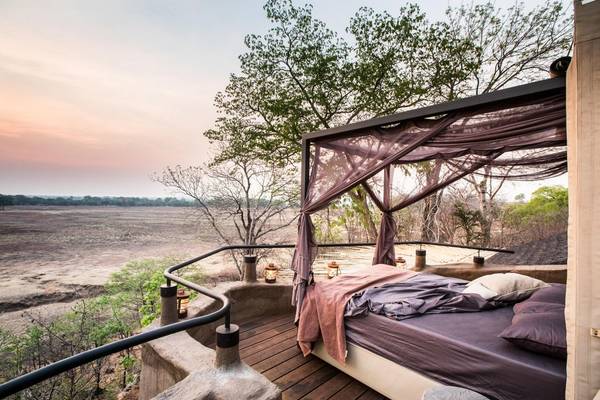Wildlife Holidays in the South Luangwa






Even by African standards, South Luangwa is special. The world’s greatest wildlife continent may be blessed with countless unparalleled wilderness areas – amongst them some of the most famous reserves on the planet – but none is more spectacular than the jewel in Zambia’s wild crown. Its woodlands, savanna and wetlands support extraordinary concentrations of animals, from herds of antelope and African Buffalo to flocks of waterbirds and bee-eaters, as well as some of the finest predator-viewing in Africa. What’s more, South Luangwa National Park still does not attract the same numbers of tourists that crowd other, perhaps more famous, reserves. As a consequence, visitors will often feel that they have all this splendour to themselves. South Luangwa is a wildlife destination that will delight all comers, from the first-time safari-goer to the most experienced of naturalists.
Speak with our the South Luangwa National Park specialist

Specialist Recommends
Zambia's South Luangwa is one of Africa's finest national parks (and walking safari destinations). It's an excellent choice for a first visit to Zambia, or indeed a first visit to Africa! We offer a 10-day safari at a tented camp situated deep within the park or, for those who'd prefer something more luxurious, both a bird- or mammal-focussed tour, based at Kafunta River Lodge.
Operations Manager - Paul StanburyThe Magic of Zambia's South Luangwa
Although Portuguese traders first came to the area in the 16th century, it wasn’t until the 1800s that European exploration commenced in earnest. From the very beginning, it was clear that the Luangwa Valley was remarkable – visitors around this time described the incredible numbers of wild animals that they encountered. In 1904, a game reserve was declared on the eastern bank of the Luangwa River, but it was not maintained and poaching was rampant. However, in 1938 the South Luangwa Game Reserve was gazetted and this, along with some adjacent tribal land, became a national park in 1972. Today, the park covers over 9,000 square kilometres of woodland savanna, bounded to the west by the steep Mchinga Escarpment and to the east by the river. Those great profusions of animals that so impressed the early explorers can still be seen, making South Luangwa a wildlife destination like no other.
With many African reserves, it is often the big mammals that first capture the attention. South Luangwa is no exception, supporting thriving populations of many of the continent’s most iconic species. Large herds of African Savanna Elephant crossing the river are a frequent sight, with Hippopotamus wallowing in the deeper pools and gatherings of Puku, Plains Zebra and Impala dotting the grassland. Another special inhabitant of the area is Thornicroft’s Giraffe, with its intricate coat pattern and stately appearance. Recent research has revealed that giraffes in Africa actually comprise four different species; remarkably, Thornicroft’s turns out to be a subspecies of the Masai Giraffe, a species otherwise found only in Tanzania and southern Kenya. Other obvious herbivores in the park include African Buffalo, Waterbuck and Greater Kudu, with its stunning spiral horns. Although a visit at any time of year will be sure to produce superb mammal sightings, the end of the dry season, around October and November, is when visibility is best and the largest herds congregate around dwindling water sources.
Of course, such an abundance of ungulates supports healthy populations of large predators. Lions are numerous here – the Luangwa Valley is recognised as one of the most important areas in Africa for their conservation, and sightings are practically guaranteed. Spotted Hyaena, too, is common, and South Luangwa has in recent years become one of the best places on the continent to find African Wild Dog. Packs of this endangered canid, often described as Africa’s most efficient hunter, cover vast territories but are seen here with increasing regularity – there are thought to be over 350 individuals in the Luangwa Valley.
It is, however, another carnivore for which the park is perhaps best known. Leopards thrive in South Luangwa’s riverine woodlands, with their unfailing supply of prey; densities here are amongst the highest on Earth. Typically elusive across their wide range, it isn’t unusual for visitors here to encounter these beautiful big cats every day. This is particularly true after dark, when they are at their most active. In most major African national parks, this would not be allowed, but South Luangwa permits night drives. These produce sightings not just of Leopards, but also of a host of other elusive nocturnal creatures; this can include Honey Badger, African Civet, Large-spotted Genet, Southern Lesser Galago (Bushbaby), White-tailed Mongoose and many more animals that are difficult, if not impossible, to see during the day. The ultimate night drive mammal target, seen by only the lucky few, is the bizarre Aardvark.
Another exciting way of observing South Luangwa’s wildlife is on foot. This park is the spiritual home of walking safaris, which have been conducted here since the 1940s, when the approach was first pioneered as an alternative to big game hunting. Although it is not possible to get as close to wildlife as in a vehicle, exploring the bush on foot provides a uniquely intimate experience – birdsong seems louder, smells and sounds more intense, and the visitor feels infinitely more connected with the wilderness around them. There is nothing quite so exciting as watching a herd of Elephants from the shade of a nearby Acacia, or following fresh Lion tracks along a great sandy bend in the Luangwa River. Happily, many of the park’s luxurious safari camps provide the best of both worlds, allowing both walks and drives. However, for the more adventurous, treks lasting up to a week or more are also available.
Of course, there is far more to South Luangwa’s natural history than mammals. The park’s birdlife, especially along the river, must be seen to be believed. Most spectacular of all are the huge, riotously colourful colonies of Southern Carmine Bee-eaters – these stunning red-and-blue birds arrive to breed in August, and decorate sandbanks along the Luangwa for just a few months. Other species are a more permanent fixture around water, such as African Fish Eagle, Saddle-billed, Woolly-necked and Yellow-billed Storks, White-crowned Lapwing and Hamerkop. Birds of prey, including Martial Eagle, Lizard Buzzard, White-backed Vulture and African Harrier Hawk, are common and diverse, while woodlands contain such marvels as Southern Ground Hornbill, Lilian’s Lovebird, Woodland Kingfisher, Purple-crested Turaco and the amazing African Emerald Cuckoo. Many of these birds are as conspicuous as they are beautiful, making for a richly rewarding birding experience. Furthermore, night drives, as well as producing sightings of mammals such as Leopard, can be excellent for nocturnal birds – amongst the possibilities are Square-tailed and fantastic Pennant-winged Nightjars, Spotted and Verreaux’s Eagle Owls, Three-banded Courser, or even the rare and gorgeous Pel’s Fishing Owl. Many of these birds are present in the national park year-round, but the keenest birders will find things most rewarding between November and February, when most species are breeding and migrants (both European and intra-African) are present.
All in all, it is difficult to imagine a more appealing safari destination than South Luangwa. Free from the swarms of tourist vehicles that can dominate other more famous reserves, the park offers a richness and variety of experience that is simply unmatched. When combined with some of the continent’s most majestic scenery, this makes South Luangwa somewhere that everyone with a love of Africa and its wildlife should visit.



 Loading search...
Loading search...










